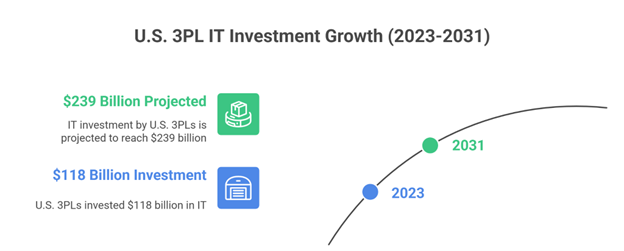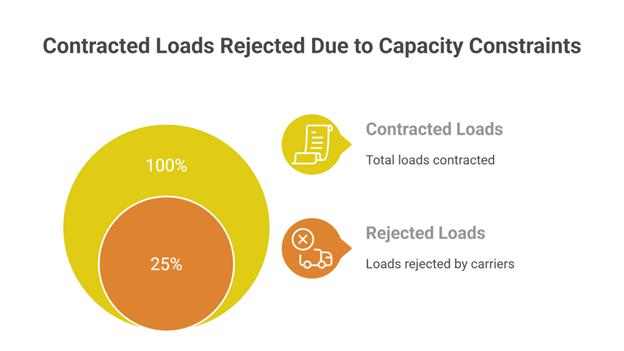8 min read
3PL Inventory Management for Household Goods: 5 Strategies
Managing inventory for household goods is different from handling other products. Furniture pieces take up serious warehouse space, bedding comes...

Peak seasons hit fast. One day you're handling your regular order volume, and the next you're drowning in customer demands that seem impossible to meet. Your warehouse is packed to capacity, your staff is stretched thin, and delivery deadlines are getting tighter by the hour.
And it's about more than just moving boxes. When peak season arrives, everything intensifies at once; one mistake can lead to customer complaints and lost revenue. If you miss a delivery deadline or run out of stock on a hot item, you're not just losing a sale; you're potentially losing that customer for good.
So how do 3PLs (third-party logistics) manage peak season demand while keeping operations smooth? Let's explore the methods that make 3PL providers essential partners during the busiest times of the year!
20 Years of Kitting Excellence
Ready to Streamline Your Supply Chain?
Join industry leaders achieving 99%+ SLA performance with flexible kitting.
Fulfillment, and 3PL solutions. We handle over 100 million kits annually
When order volumes spike during peak season, 3PLs expand quickly without compromising quality. Their infrastructure is explicitly designed to handle these demand surges.
3PL providers maintain excess warehouse capacity across multiple facilities specifically for peak periods. When your holiday inventory arrives and sales exceed projections, there's room to accommodate it without scrambling for overflow storage.
With this model, you only pay for the space you actually use during slower months. During the peak season when you need to triple your normal square footage, it's available immediately, without long-term leases or wasted space sitting empty for most of the year.
Navigating staffing demands during peak season requires expertise and precision that 3PLs have. They recruit, train, and manage temporary workforces for multiple clients each year. Your 3PL knows when to ramp up staffing and maintains relationships with experienced seasonal workers who return each year.
For example, a report states that major U.S. providers such as Amazon and UPS planned to hire approximately 250,000 and 125,000 seasonal workers for the 2024 holiday season, underscoring the importance of workforce planning.
During peak periods, 3PLs operate extended hours and add weekend shifts to ensure orders continue to move; they manage all the scheduling complexity, overtime, and shift coverage. This allows you to increase capacity without any additional management burden.

Delivering products during peak season requires more than just shipping; it demands strategic carrier partnerships and meticulous logistics planning. 3PLs excel at both.
Relying on a single carrier during peak season is a risky strategy. When one gets backed up or reaches capacity, your deliveries grind to a halt. On the other hand, 3PLs work with multiple carriers simultaneously, giving them options when bottlenecks occur.
Having established relationships also means you can secure better rates and receive priority treatment when capacity becomes tight. Carriers know 3PLs ship high volumes year-round, so they're more likely to accommodate rush orders and provide reliable service even during the busiest weeks.
Smart routing technology ensures that packages take the fastest and most cost-effective paths to customers. During peak season, 3PLs continuously analyze transportation routes and adjust them in real time based on conditions such as weather delays, traffic patterns, and carrier performance.
Last-mile delivery is where costs tend to spike and delays occur most frequently. 3PLs optimize this by strategically locating inventory closer to customers and selecting carriers based on regional performance. The result is faster deliveries at lower cost, even during peak demand.
Modern 3PLs rely on advanced systems to manage the complexity of peak seasons. Technology provides the visibility and intelligence needed to make fast, accurate decisions.
Predictive analytics enable 3PLs to anticipate demand patterns before the peak season arrives. By analyzing previous sales data, market trends, and seasonal patterns, they can accurately forecast which products will be in high demand and ensure adequate stock levels well in advance.
In fact, according to a market research report, U.S. 3PL providers invested approximately $118 billion in 2023 on IT systems that support forecasting and inventory planning, with spending projected to reach $239 billion by 2031, underscoring the scale of technology driving these capabilities.
These forecasting tools prevent the two worst scenarios: running out of bestselling items during your busiest weeks, or overstocking products that tie up valuable warehouse space. Thoughtful inventory planning means your 3PL has the right products in the right quantities exactly when customer demand peaks.

Real-time tracking systems provide you with constant visibility into inventory levels, order status, and fulfillment progress throughout the peak season. You can see exactly what's in stock, what's being picked and packed, and where shipments are in transit.
That’s why transparency is critical when you have to handle customer inquiries during busy periods. Instead of guessing about order status or making customers wait for updates, you can provide immediate, accurate information that keeps them satisfied even when delivery times stretch longer than usual.
Peak-season success depends on clear, consistent communication between 3PLs and their clients. When everyone stays aligned, problems get solved before they impact customers.
Good 3PL providers keep you informed throughout peak season with real-time dashboards showing order accuracy, fulfillment speed, and inventory levels. You're not waiting for weekly reports or chasing down updates; the data is always available when you need it.
Performance metrics matter even more during busy periods. Tracking KPIs, such as on-time shipping rates and order accuracy, helps identify issues early. If fulfillment times start creeping up or errors increase, your 3PL can adjust processes immediately rather than waiting for customer complaints to roll in.
A strong 3PL partnership elevates your customer service during peak season by integrating processes between your team and the fulfillment center. For example, they set up systems that enable your support staff and fulfillment team to share order statuses and shipping details in real-time, ensuring that information flows effortlessly when customers have questions.
With access to fulfillment data, your team can resolve inquiries instantly and maintain customer satisfaction, even when delivery times are longer than usual.
Experience makes all the difference during peak season. 3PLs that have successfully managed multiple busy seasons know what to expect and how to handle unexpected problems.
Every peak season teaches valuable lessons. Innovative 3PL providers analyze what works, what doesn't, and where bottlenecks occur. They use this data to refine processes, adjust staffing levels, and improve systems before the next busy period arrives.
Continuous improvement means your 3PL becomes better at handling peak demand each year. They're not figuring things out as they go. Instead, they're applying proven strategies refined over previous successful holiday seasons for multiple clients across different industries.
Despite meticulous planning, even the busiest peak seasons can be fraught with unexpected disruptions. About 25% of contracted loads in the U.S. are rejected by carriers during peak season due to capacity constraints, highlighting the need for backup networks. Carriers encounter delays, adverse weather alters shipping routes, or unanticipated demand outpaces forecasts. Experienced 3PLs anticipate these challenges and have backup plans in place.
Contingency planning involves 3PLs forming backup carrier relationships when primary options reach capacity, securing overflow warehouse space for inventory surges, and negotiating flexible staffing agreements to facilitate rapid workforce expansion. When problems arise, your 3PL quickly responds because they are prepared for these situations.

Start planning at least 3-4 months before peak season hits. This gives your 3PL time to forecast demand, secure additional warehouse space, arrange seasonal staffing, and coordinate with carriers. Early preparation also enables effective inventory planning and ensures that products arrive well in advance of the rush. The best partnerships involve quarterly planning sessions where you share sales projections and discuss capacity needs ahead of busy periods.
3PLs prevent delays through diversified carrier networks, early contract negotiations for guaranteed capacity, and strategic inventory positioning closer to customers. They use real-time tracking to monitor carrier performance and quickly reroute shipments when problems arise. Extended operating hours and weekend shifts during peak periods ensure that orders continue to process without bottlenecks. Experienced 3PLs also build buffer time into delivery estimates and communicate proactively about any potential delays.
Absolutely. Small businesses benefit even more because they gain access to enterprise-level infrastructure, carrier rates, and expertise they couldn't afford on their own. A 3PL handles the complexity of scaling for peak season, including additional warehouse space, seasonal staffing, and transportation logistics, without requiring a massive upfront investment. This levels the playing field, letting small businesses compete with larger companies on shipping speed and reliability during their busiest times.
Productiv combines high-touch communication with fixed unit pricing, eliminating surprise costs during busy periods. Our experienced teams scale efficiently for peak seasons while maintaining quality through real-time SLA (Service Level Agreement) dashboards. We say yes to unique requirements, such as special holiday packaging or last-minute kitting, and our flexible value-added services adapt to your needs. You'll have direct access to decision-makers who solve problems fast, not layers of customer service reading from scripts.
At Productiv, we've proven our ability to handle peak season challenges through tangible results. We've onboarded new customers just one month before their busiest period and successfully shipped over two million direct-to-consumer units for Black Friday sales. Our advanced warehouse management systems provide real-time visibility into inventory and order status, while our strategic locations and strong carrier relationships ensure fast, efficient fulfillment, even during peak demand.
What sets us apart is our combination of fixed unit pricing that eliminates surprise costs, proactive communication with direct access to decision-makers, and flexible operations that scale efficiently without compromising quality. Whether it's the holiday rush or another high-demand period, Productiv has the experience, technology, and commitment to help your brand thrive during peak season.
Ready to tackle your busiest times with confidence? Contact us and let's discuss how we can keep your operations running smoothly during peak season!

8 min read
Managing inventory for household goods is different from handling other products. Furniture pieces take up serious warehouse space, bedding comes...

11 min read
Running a growing business means managing more than just sales: it’s storage, shipping, and supply chain chaos. One delayed shipment or warehouse...

9 min read
Partnering with a 3PL (third-party logistics) sounds simple until you hit inventory transfers, integrations, and lost orders. Most businesses think...